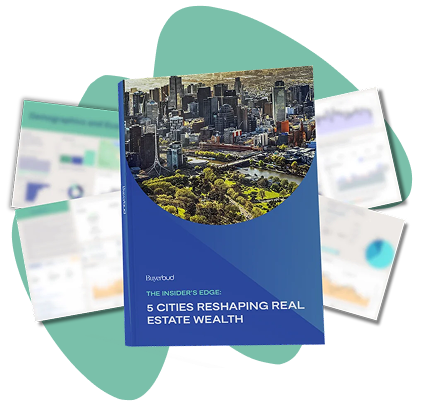
Yesterday, a client called me excited about a “guaranteed 6% rental return” on a brand new apartment. The marketing was slick, the renders looked stunning, and the sales agent promised it would be “perfect for investors.”
I asked one simple question: “What’s the resale value going to be in 12 months?”
Silence.
That conversation happens more often than you’d think. Let me show you why new builds can be financial quicksand for most investors.
The Marketing vs The Mathematics
What They Promise:
Guaranteed rental returns (usually 5-7%)
No maintenance costs for years
Latest features and finishes
Depreciation benefits
“Get in early” pricing
What The Numbers Actually Show:
I’ve tracked new build performance across Melbourne, Sydney, and Brisbane for over 8 years. Here’s what typically happens:
Year 1: Property settles at $650,000 (example)
Year 2: Comparable resales in same building: $580,000-$600,000
Year 3: Rental guarantee expires, market rent drops to 4.2%
Year 5: Still struggling to reach original purchase price
That’s a $50,000-$70,000 loss in the first 12 months alone.
Why New Builds Lose Value Immediately
The Developer Margin Problem: When you buy off-the-plan, you’re paying:
Land cost
Construction cost
Developer profit
Marketing costs
Sales commissions
When you try to sell, buyers only consider:
Land value
Replacement cost of an older building
The developer’s profit and marketing costs? Gone forever.
Supply Surge Reality: New developments rarely build one apartment. They build 50, 100, or 200 units that all settle within months of each other. Suddenly, your “unique” investment has dozens of identical competitors in the same building.
I’ve seen entire floors of apartments listed for sale simultaneously, creating a race to the bottom on pricing.
The Guaranteed Return Mirage
How “Guaranteed” Returns Actually Work:
The developer pays you 6% for two years on a $650,000 apartment ($39,000 annually). Sounds great, right?
Here’s the problem: they’ve inflated the purchase price by $80,000 to fund this guarantee. You’re essentially paying yourself with borrowed money.
After the guarantee expires, market rent on your property is often 15-20% below what established buildings achieve. Tenants prefer character, location, and value over brand new finishes that everyone else has.
When New Builds Make Sense (The Exceptions)
Exception 1: Land-Rich Developments Some new builds work when:
Large land component (houses, not apartments)
Established suburbs with limited new supply
Infrastructure driving genuine demand
Exception 2: Your Primary Residence If you’re buying to live in and value:
Modern features and warranties
No immediate renovation needs
Energy efficiency
Then the financial hit might be worth the lifestyle benefits.
Exception 3: Unique Locations Occasionally, new builds in genuinely constrained locations (waterfront, CBD fringe) can work due to scarcity value.
What Experienced Investors Buy Instead
10-20 Year Old Properties:
Past the initial depreciation hit
Proven rental history
Established neighborhood character
Renovation potential to add value
Established Apartments in Quality Buildings:
1960s-1980s construction often superior to modern builds
Larger floor plans and better natural light
Lower body corporate fees
Proven capital growth history
Houses in Growth Corridors:
Land appreciation drives long-term returns
Renovation and subdivision potential
No body corporate fees
Greater tenant appeal
The Questions You Should Ask
Before considering any new build investment:
“What did the last resale in this building sell for?” (Often 10-15% below new prices)
“How many other units are settling in the next 6 months?” (Your competition)
“What’s the rental rate in established buildings nearby?” (Usually higher than new builds)
“Can I buy a 5-10 year old property in the same area for less?” (Usually yes)
“What’s driving demand in this specific location?” (Beyond marketing claims)
The Depreciation Myth
The Reality About Tax Benefits:
Yes, new builds offer higher depreciation deductions. But depreciation doesn’t create wealth – it just delays tax.
Consider this scenario:
New build: $650,000 purchase, $15,000 annual depreciation benefit
Established property: $580,000 purchase, $5,000 depreciation benefit
The $70,000 price difference buys you 7 years of extra depreciation benefits. After that, you’re still $70,000 behind.
Smart investors understand: Capital growth beats tax benefits every time.
Red Flags to Avoid
Guaranteed Return Programs: If the return needs guaranteeing, what does that tell you about market confidence?
“Last Few Units” Pressure: Artificial scarcity to rush decisions
Rent Roll Projections: Often 10-20% above market reality
“No Comparable Sales”: Means you can’t verify pricing
Sunset Clauses: Developer can cancel if pre-sales are slow
The Bottom Line
New builds aren’t necessarily bad investments – they’re just overpriced for what you get. The marketing machine is powerful, but the mathematics don’t lie.
Most investors would be better off buying a quality established property for $100,000 less and spending $20,000 on improvements. You’ll have better cash flow, proven growth potential, and no nasty surprises when the marketing promises meet market reality.
The property development industry needs buyers for new stock. That doesn’t mean you need to be one of them.





